|
You are receiving this newsletter because you subscribed to fijistamps.info
Not interested anymore? Unsubscribe. Having trouble viewing this email? View it in your browser.
|
|
|

A New Find
|
|
|
G'day and Bula to all my Fiji collecting colleagues. Here we are with our second newsletter for the year. I've got a few new interesting finds and hopefully a couple of articles you'll find useful.
As promised in my previous newsletter, I have continued to add new finds as they are discovered into the Fiji Stamps Information website - FijiStamps.info. Below are just a few examples of recent new finds. Also with the recent release of Scott catalogue 2014, I'll look at how the strong interest in these Fijian overprints has stimulated the big catalogue guys to get onboard.
A big hello to all the new subscribers, it's really great to see the continued growing interest in Fiji's longer running "Emergency" overprint issues.
I hope you all enjoy this issue of the FijiStamp.info Newsletter. Thanks you, Vinaka
|
|
|
|
The 31c base series with the 1c, 2c, 3c, 4c, 5c, 20c and 40c values with small "xxx" continue as the current overprint series for post offices requiring stamps of these values that can not be filled with regular issues.
Although there has not been any new standard issues announced recently, an interesting assortment of new found varieties continue to be uncovered.
back to top
|
This is the most exciting part of collecting this overprint series, issues that may have been printed some time ago come to light only after someone with a keen eye notices something different.
There's been a few newly discovered varieties of not-so-recently released items, below are just a few that I have added to the FijiStamps.INFO listing in the last few months.

|
Large 20c on 31c - Large "XX" - 4mm spacing
This (trial) variety only came to light on the Stampboard.com site last month. Prior to this discovery there were known trials of the 20c on 31c "XXX" but not of this "XX" variant. As the majority of the 20c on 31c overprints where printed using the "xxx" commencing in March 2011, it would be reasonable to assume this "trial" predates this finally used "xxx" format.
So the big question is - How many examples of this "XX" issue exist? - which was probably printed more than 2 years ago.
My guess would be one sheet.
|
4c on 18c - Overprint Inverted and shifted downwards 50%
Two sheets are known of the 4c on 18c overprint, both are with the overprint inverted BUT the first sheet (#052502) has all overprinted as normal inverted. The second sheet (#05203), where this example comes from, has the top half sheet with inverted overprint also shifted down by 50%, the lower half sheet has standard inverted overprint.
|
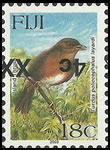
|
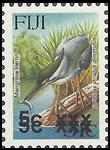
|
5c on 31c "xxx" 2.5mm Overprint Double, One 10% Upwards
This variety only recently came to light when a single sheet was noticed with just the top two rows (R1-2) exhibiting the Double Overprint variety. The remainder of the sheet simply contains the normal 5c on 31c "xxx" 2.5mm overprint.
|
back to top
|
Scott Catalogue 2014 review
|
After many months of reviewing and deliberating, the latest release of Scott catalogue with a number of Fiji Overprints Series updates is here. On first review, it's exciting to see that this new release has taken onboard a good number of additional varieties. They have also incorporated a large number of images which will greatly help collectors with identifying which items they currently have in their collection, and which ones they are still needing.
A few highlights from this new Scott catalogue release:
- There are a good selection of new numbered listings, including
- Base Issues:
- 2c/6c xxx 4mm
- 2c/23c XX 5mm
- 20c/31c XX 4mm
- 20c/31c xxx 1.5mm
- Varieties:
- 2c/1c xx Gap 2 c
- 4c/6c xxx 4mm - 2.5mm spacing (R1/3, R9/9) (Note1)
- 20c/6c XX 1.5mm - NoGap (R8/9)
- 20c/6c xxx 1.5mm - NoGap (R7/10)
- 2c/13c XX 5mm - 4mm spacing (R1/3, R9/9) (Note2)
- 4c/13c XX 5mm - 4mm spacing (R1/3, R9/9) (Note2)
- 1c/23c xxx 4mm - 3mm spacing (R1/3, R9/9) (Note3)
- 2c/23c xxx 4mm - 3mm spacing (R1/3, R9/9) (Note3)
- 4c/23c xxx 4mm - 3mm spacing (R1/3, R9/9) (Note3)
- 20c/31c xxx 1.5mm - 2.5mm spacing (R1/1, R2/1)
- 20c/31c xxx 1.5mm - No Gap (R7/10)
Note1: Also exists on 2c/6c xxx
Note2: Also exists on 1c/13c XX
Note3: Also exists on 3c/23c xxx, 5c/23c xxx
Note4: Numerous 31c overprints still to be documented in future revision.
- In addition to new numbering an additional 44 newly priced varieties have been included within the footnotes of individual base overprint items.
Here's a few examples of some of the newly priced overprint varieties:
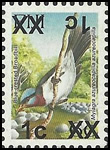
|
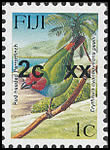
|
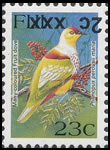
|
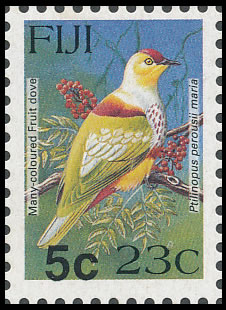
|
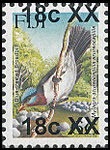
|
|
Double Overprint, One Inverted
|
Overprint Shifted 50% Upwards
|
Overprint Inverted
|
Overprint Missing "xxx"
|
Overprint Double, One 90% Upwards
|
I would recommend any Fiji collector to consider adding the latest Scott catalogue to your library of reference materials.
I now eagerly anticipate Stanley Gibbons' revised Western Pacific catalogue release to see how far they choose to go with documenting this most comprehensive issue. Starting in 2006, we are now into its 8th year and still going strong.
back to top
|
A quick look at some printing challenges:
|
With rising overheads (wages, rent, stock, etc., etc.) and declining business, resulting in a difficult cash flow situation, Post Fiji made a commercial decision to use up their overstocks by overprinting them so that they can be married to other "wrong" values in order to meet the current postal rates in force. An audit of current inventory revealed they had huge stocks of the Bird definitive (estimated sufficient for about 20 years of use) as well as a range of other unsold commemorative issues. As these stocks had already been paid for, overprinting the low values was a wise decision. At the same time, all Post Offices were instructed not to use their Machine Cancellers so that only actual stamps can be used. This is still in effect today.
Fiji is a tropical country and really only has two seasons; summer/winter or hot/cold. With Fiji Post Philatelic Bureau being located in Suva, which fortunately has the sea breezes blowing most days, it is still normally very humid, unlike the Western District which is hot and dry. Remember, these Bird Definitives were issued back in 1995, that's 18 years ago.
When these issues were stored in the Philatelic Bureau vault, they were stacked on wooden shelves up to 10 reams high in non-airconditioned premises. Some of these may have been touching the concrete walls thus causing the sheets to stick together more quickly. As far as I know, there were no lamps in the vaults to reduce the moisture or humidity. Also since the time of the original printing to now, the stocks have been moved to different locations at least on three occasions as the Philatelic Bureau shifted their offices.
The long term storage has certainly been a significant contributor in the overall callenge of sheets misfeeding. I heard that the printers have been instructed to "fan" the sheets first (to loosen any stickiness) before printing, sometimes they still get stuck or dragged during printing. As a result of this, the overprints get displaced or skewed to different degrees.
Another factor is that the operators are basically trained to print on stationery and not on stamps (with sticky gum on one side). The only Printery with some success was the Star Printery. Although the first overprints were done in 2006, it was also assumed that there were highstaff movements regularly all looking for a higher pay. If the operators are not careful or do not concentrate in their work fully, they will make mistakes in paper loading/feeding, ink refilling, etc. That is where the errors and varieties are made. Sometimes it could be the effects of too much "kava kava" the night before. Post Fiji will use any of the overprints if they consider it is "fit for the job".
Misalignment
|
Sheets misfeeding through the printing machine(s) has been a problem since the beginning of the overprint series, though with the growing number of issues within this series it feels like the number of misalignment varieties is accelerating (as you may have noticed in the Recent Releases section of the last Newsletter). My take on this feeling is that quantities of some of the more recent prints has increased, as well as the demands on the printers to provide greater volume output in shorter, more aggressive timeframes. Hence mistakes will naturally increase proportionally to the volume and time permitted to complete the required batch overprint runs.
The most common types of misalignment include:
- Overprint Inverted - occurs when the sheet being overprinted was upside-down within the stack of sheets being sent through the printing machine
- Overprint shifted up or down - the rollers of the printing machine has not cleanly grabbed and feed the sheet through the machine
- Overprint skew - this happens when a sheet twists as it passes through the printing machine. These sheets are often classified "printers waste" and are recorded as damaged during printing.
Here are just a few examples of misalignment varieties.
|

|
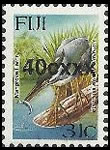
|
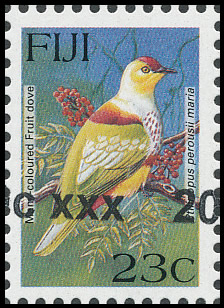
|
|
Overprint Inverted
|
Vertical Shift
|
Overprint Skewed
|
|
As all sheets provided by Fiji Post to the printing company must be accounted for, all overprinted sheets including damaged sheets must be returned. It is Fiji Post who determines which sheets can be dispatched to Post Offices and Agencies or must be destroyed (NOTE: Many of these misalignment varieties are known used, confirming that as long as the overprint is on the stamp then the overprinted sheets are generally dispatched for use.
An unknown number of damaged sheets have been destroyed, never to see the light of day. The below example is an early 18c on 6c sheet that was cleared for postal use ... the fact that the printer needed to use sticky tape to hold the sheet together, personally I would have destroyed this one ... A great example of the pressure the Fiji Post was under to get fresh stamp supplies, even if they are just "overprinted" stamps, out to the Postal Agencies to meet depleting stamp stock levels.
|
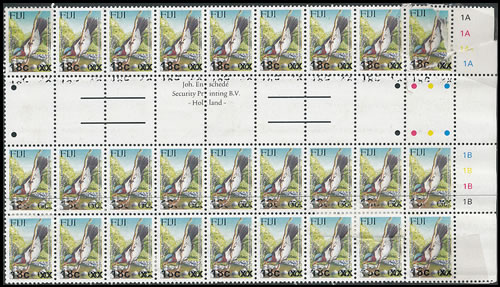
|
Underinking
|
Over the last 6-12 months a number of examples have been circulating in the usual "For Sale" locations such as eBay stating to be examples of underinking. There are a couple of points that should be considered when looking at such "varieties":
- Insufficient ink during printing
- Overprint master template missing part of the overprint
- Ink flaking off post-overprinting
Unlike the misalignment issues discussed above, varieties relating to the actual overprints integrity become a little more interesting. It is true, and there are many examples to reinforce that the printers did suffer from issues where the ink level across an overprint sheet varied, resulting is partial overprinting of some of the overprints.
|

|
|
Where the topic of underinking gets interesting is when an item is reported to only have part of its overprint intact, that is the rest of the overprint is no longer present. This type of overprint anomaly basically falls into two areas:
- a part of the overprint was mistakenly never overprinted. Example of this variety include the 5c on 23c WITHOUT the "xxx", and the 1c/23c, 2c/23c and 3c/23c when on position R7/10 instead of printing "xxx" the overprint was mistakenly used of "xx".
- a part of the overprint has been removed, either accidentally or deliberately. A number of items have appeared on eBay recently which reported parts of the overprint to have not been printed, be careful, I believe the majority of these have potentially been tampered with, and hence would never be considered collectible - definitely not a good investment.
The easiest way to differentiate between (1) and (2) above is to check for an albino overprint, that is the indentation when the overprint should be is present on the stamp but there is no ink
|
Here are a few additional examples of (legitimate) underinking varieties.

|
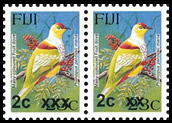
|
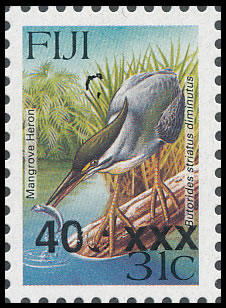
|
|
Part Overprint Missing (Entire Sheet)
|
Overprint Missing "x" (only R7/10)
|
Inking issue on "c"
|
Here are a few additional examples of damaged ink through postal use.
The good news is even with these extra dimensons to the scope of this series, these overprints have found immense interest by a lot of dedicated collectors worldwide. Over the years there are quite a few philatelists who have built up spectacular and awesome collections. This has certainly helped by Scotts and Gibbons Catalogues'. Let us hope that Gibbon's 2013 Western Pacific Catalogue will improve their listing of all the issues.
back to top
|
Other News
Fiji Stamps FOR SALE
I have had a number of enquiries relating to supply of various Fiji issues, not surprising most commonly the Overprint series which has dominated my newsletters to date. In response to the interest I am pleased to advise that I am able to take any Fiji philatelic enquiries and through my own stock, together with my Fiji dealer community, help to fill those nagging gaps in your collections.
For more details or to send your Want List .... Click Here »
back to top
|
Feedback always welcome
If you have any feedback or recommendations for improving the site, or this communique, I would love to hear from you... Provide feedback »
back to top
|
|
|


















